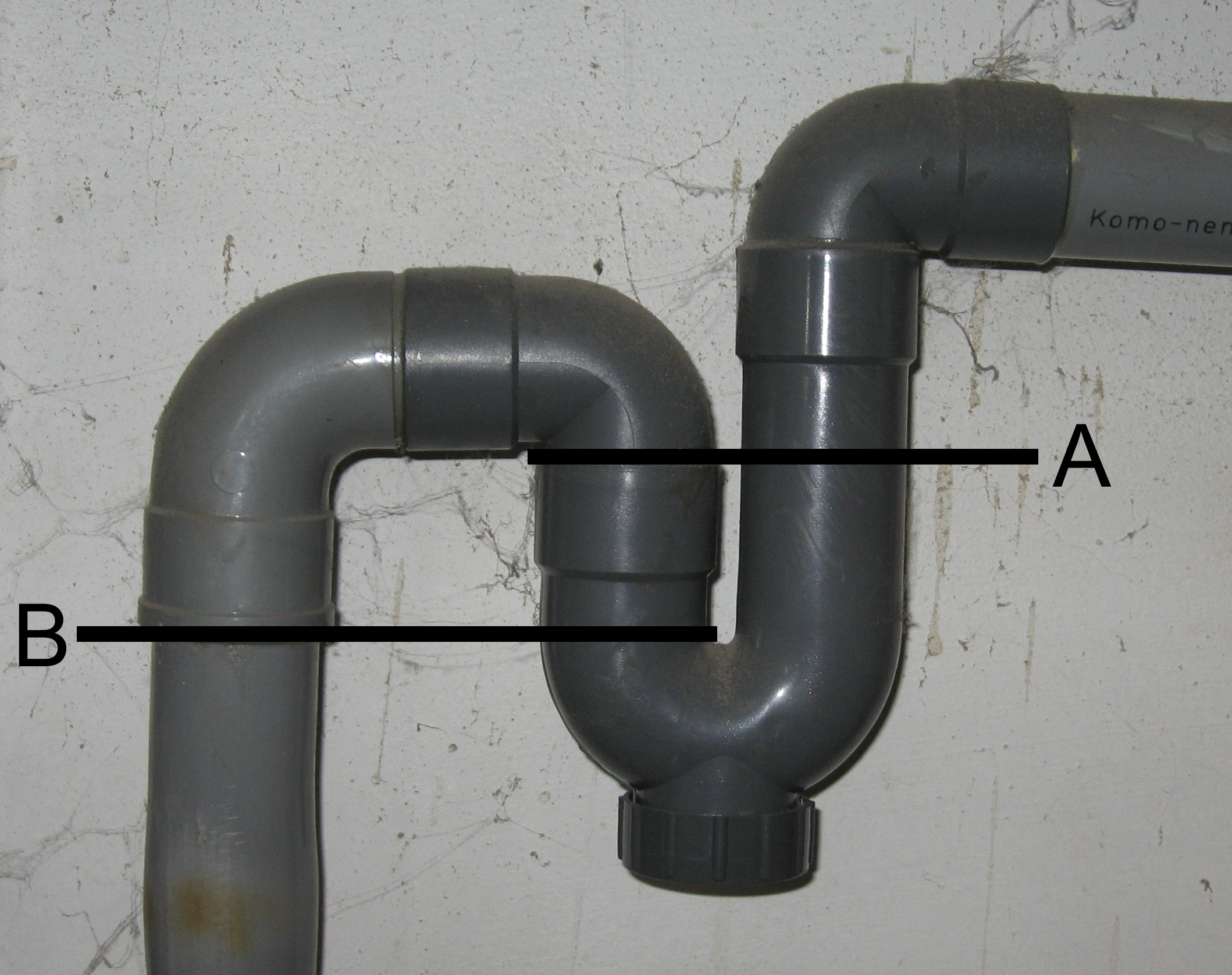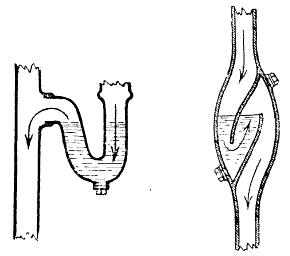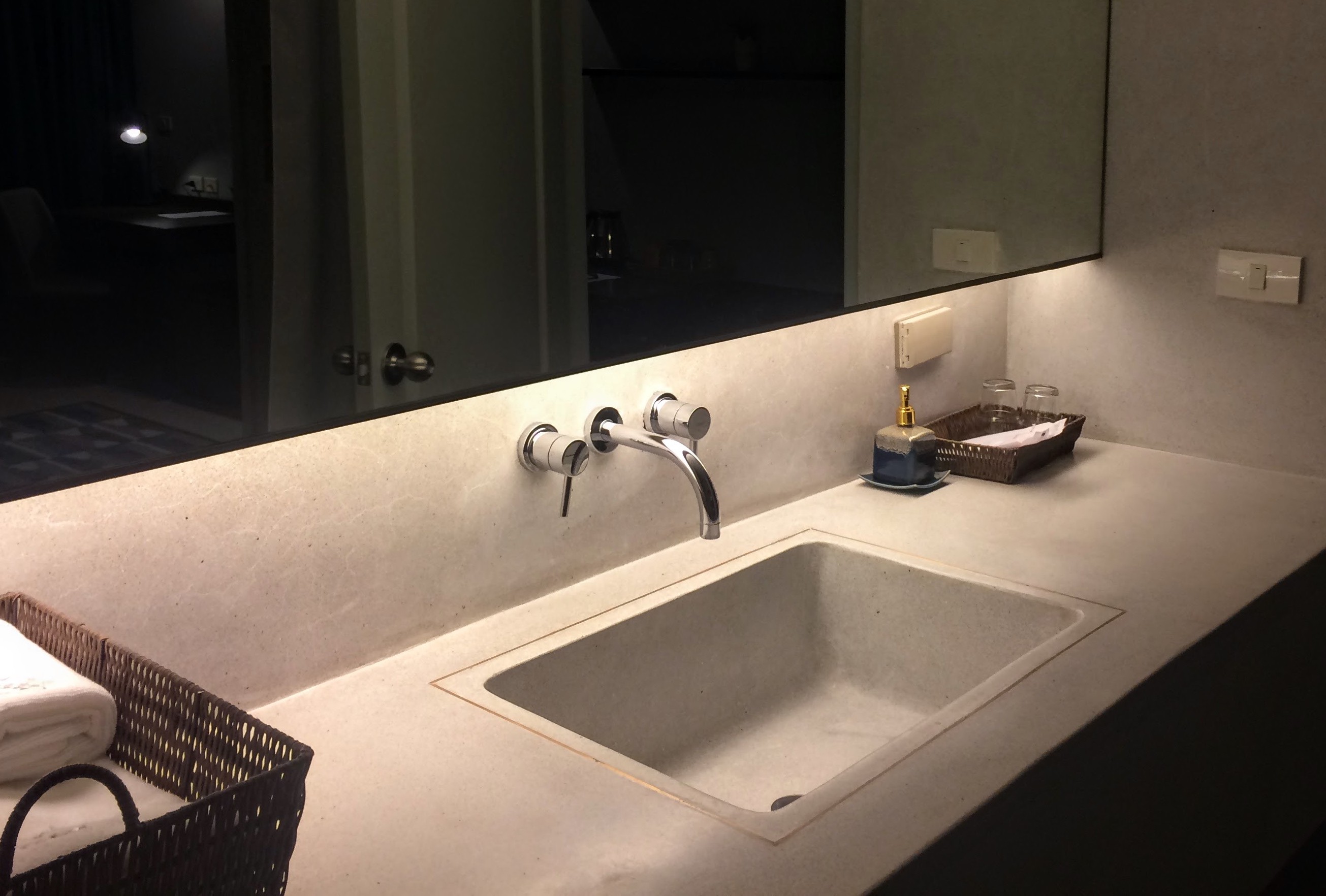|
Trap Primer
A trap primer (or trap seal primer) is a plumbing device or valve that adds water to traps. The water seals in traps are needed to prevent sewer gases from entering buildings, but because this water is exposed to the air, it is subject to evaporation over time in infrequently used floor drains, leading to the release of sewer gas into the environment. The trap primer mitigates this problem by injecting water, either directly or indirectly, into the trap to maintain the water seal indefinitely. Building codes may require trap primers for traps in certain locations or situations, usually those in which industry experience has shown that they are likely to dry out. The most common requirement is for basement floor drains, which are only used when the basement floods. Sometimes they are also installed in locations where the plumbing code does not require a primer because of a high probability of the trap drying out, but because of a nearby ignition source and the explosion hazard in ... [...More Info...] [...Related Items...] OR: [Wikipedia] [Google] [Baidu] |
Plumbing
Plumbing is any system that conveys fluids for a wide range of applications. Plumbing uses pipes, valves, plumbing fixtures, tanks, and other apparatuses to convey fluids. Heating and cooling (HVAC), waste removal, and potable water delivery are among the most common uses for plumbing, but it is not limited to these applications. The word derives from the Latin for lead, ''plumbum'', as the first effective pipes used in the Roman era were lead pipes. In the developed world, plumbing infrastructure is critical to public health and sanitation. Boilermakers and pipefitters are not plumbers although they work with piping as part of their trade and their work can include some plumbing. History Plumbing originated during ancient civilizations, as they developed public baths and needed to provide potable water and wastewater removal for larger numbers of people. The Mesopotamians introduced the world to clay sewer pipes around 4000 BCE, with the earliest examples found i ... [...More Info...] [...Related Items...] OR: [Wikipedia] [Google] [Baidu] |
Valve
A valve is a device or natural object that regulates, directs or controls the flow of a fluid (gases, liquids, fluidized solids, or slurries) by opening, closing, or partially obstructing various passageways. Valves are technically fittings, but are usually discussed as a separate category. In an open valve, fluid flows in a direction from higher pressure to lower pressure. The word is derived from the Latin ''valva'', the moving part of a door, in turn from ''volvere'', to turn, roll. The simplest, and very ancient, valve is simply a freely hinged flap which swings down to obstruct fluid (gas or liquid) flow in one direction, but is pushed up by the flow itself when the flow is moving in the opposite direction. This is called a check valve, as it prevents or "checks" the flow in one direction. Modern control valves may regulate pressure or flow downstream and operate on sophisticated automation systems. Valves have many uses, including controlling water for irrigation, ... [...More Info...] [...Related Items...] OR: [Wikipedia] [Google] [Baidu] |
Trap (plumbing)
In plumbing, a trap is a U-shaped portion of pipe designed to trap liquid or gas to prevent unwanted flow; most notably sewer gases from entering buildings while allowing waste materials to pass through. In oil refineries, traps are used to prevent hydrocarbons and other dangerous gases and chemical fumes from escaping through drains. In heating systems, the same feature is used to prevent thermo-siphoning which would allow heat to escape to locations where it is not wanted. Similarly, some pressure gauges are connected to systems using U bends to maintain a local gas while the system uses liquid. For decorative effect, they can be disguised as complete loops of pipe, creating more than one U for added efficacy. General description In domestic applications, traps are typically U, S, Q, or J-shaped pipe located below or within a plumbing fixture. An S-shaped trap is also known as an S-bend. It was invented by Alexander Cumming in 1775 but became known as the U-bend following t ... [...More Info...] [...Related Items...] OR: [Wikipedia] [Google] [Baidu] |
Liquid Trap Seal
In plumbing, a trap is a U-shaped portion of pipe designed to trap liquid or gas to prevent unwanted flow; most notably sewer gases from entering buildings while allowing waste materials to pass through. In oil refineries, traps are used to prevent hydrocarbons and other dangerous gases and chemical fumes from escaping through drains. In heating systems, the same feature is used to prevent thermo-siphoning which would allow heat to escape to locations where it is not wanted. Similarly, some pressure gauges are connected to systems using U bends to maintain a local gas while the system uses liquid. For decorative effect, they can be disguised as complete loops of pipe, creating more than one U for added efficacy. General description In domestic applications, traps are typically U, S, Q, or J-shaped pipe located below or within a plumbing fixture. An S-shaped trap is also known as an S-bend. It was invented by Alexander Cumming in 1775 but became known as the U-bend following t ... [...More Info...] [...Related Items...] OR: [Wikipedia] [Google] [Baidu] |
Sewer Gas
Sewer gas is a complex, generally obnoxious smelling mixture of toxic and nontoxic gases produced and collected in sewage systems by the decomposition of organic household or industrial wastes, typical components of sewage. Sewer gases may include hydrogen sulfide, ammonia, methane, esters, carbon monoxide, sulfur dioxide and nitrogen oxides. Improper disposal of petroleum products such as gasoline and mineral spirits contribute to sewer gas hazards. Sewer gases are of concern due to their odor, health effects, and potential for creating fire or explosions. In homes Sewer gas is typically restricted from entering buildings through plumbing traps that create a water seal at potential points of entry. In addition, plumbing vents allow sewer gases to be exhausted outdoors. Infrequently used plumbing fixtures may allow sewer gas to enter a home due to evaporation of water in the trap, especially in warm weather. The result is the most common means of sewer gas entering building ... [...More Info...] [...Related Items...] OR: [Wikipedia] [Google] [Baidu] |
Evaporation
Evaporation is a type of vaporization that occurs on the surface of a liquid as it changes into the gas phase. High concentration of the evaporating substance in the surrounding gas significantly slows down evaporation, such as when humidity affects rate of evaporation of water. When the molecules of the liquid collide, they transfer energy to each other based on how they collide. When a molecule near the surface absorbs enough energy to overcome the vapor pressure, it will escape and enter the surrounding air as a gas. When evaporation occurs, the energy removed from the vaporized liquid will reduce the temperature of the liquid, resulting in evaporative cooling. On average, only a fraction of the molecules in a liquid have enough heat energy to escape from the liquid. The evaporation will continue until an equilibrium is reached when the evaporation of the liquid is equal to its condensation. In an enclosed environment, a liquid will evaporate until the surrounding air is ... [...More Info...] [...Related Items...] OR: [Wikipedia] [Google] [Baidu] |
Building Code
A building code (also building control or building regulations) is a set of rules that specify the standards for constructed objects such as buildings and non-building structures. Buildings must conform to the code to obtain planning permission, usually from a local council. The main purpose of building codes is to protect public health, safety and general welfare as they relate to the construction and occupancy of buildings and structures. The building code becomes law of a particular jurisdiction when formally enacted by the appropriate governmental or private authority. Building codes are generally intended to be applied by architects, engineers, interior designers, constructors and regulators but are also used for various purposes by safety inspectors, environmental scientists, real estate developers, subcontractors, manufacturers of building products and materials, insurance companies, facility managers, tenants, and others. Codes regulate the design and construction of s ... [...More Info...] [...Related Items...] OR: [Wikipedia] [Google] [Baidu] |
Sink
A sink is a bowl-shaped plumbing fixture for washing hands, dishwashing, and other purposes. Sinks have a tap (faucet) that supply hot and cold water and may include a spray feature to be used for faster rinsing. They also include a drain to remove used water; this drain may itself include a strainer and/or shut-off device and an overflow-prevention device. Sinks may also have an integrated soap dispenser. Many sinks, especially in kitchens, are installed adjacent to or inside a counter. When a sink becomes clogged, a person will often resort to using a chemical drain cleaner or a plunger, though most professional plumbers will remove the clog with a ''drain auger'' (often called a "plumber's snake"). History United States The washstand was a bathroom sink made in the United States in the late 18th century.Sinks ''The Old-House Journal''; Augu ... [...More Info...] [...Related Items...] OR: [Wikipedia] [Google] [Baidu] |
Potable Water
Drinking water is water that is used in drink or food preparation; potable water is water that is safe to be used as drinking water. The amount of drinking water required to maintain good health varies, and depends on physical activity level, age, health-related issues, and environmental conditions. This 2004 article focuses on the USA context and uses data collected from the US military. Recent work showed that the most important driver of water turnover which is closely linked to water requirements is energy expenditure. For those who work in a hot climate, up to a day may be required. Typically in developed countries, tap water meets drinking water quality standards, even though only a small proportion is actually consumed or used in food preparation. Other typical uses for tap water include washing, toilets, and irrigation. Greywater may also be used for toilets or irrigation. Its use for irrigation however may be associated with risks. Water may also be unacceptable due to l ... [...More Info...] [...Related Items...] OR: [Wikipedia] [Google] [Baidu] |
Water Closet
A flush toilet (also known as a flushing toilet, water closet (WC) – see also toilet names) is a toilet that disposes of human waste (principally urine and feces) by using the force of water to ''flush'' it through a drainpipe to another location for treatment, either nearby or at a communal facility, thus maintaining a separation between humans and their waste. Flush toilets can be designed for sitting (in which case they are also called "Western" toilets) or for squatting, in the case of squat toilets. Most modern sewage treatment systems are also designed to process specially designed ''toilet paper''. The opposite of a flush toilet is a dry toilet, which uses no water for flushing. Flush toilets are a type of plumbing fixture and usually incorporate an "S", "U", "J", or "P" shaped bend called a trap that causes water to collect in the toilet bowl to hold the waste and act as a seal against noxious sewer gases. Most flush toilets are connected to a sewerage system that con ... [...More Info...] [...Related Items...] OR: [Wikipedia] [Google] [Baidu] |
Moen Incorporated
Moen is an American product line of faucets and other fixtures started by inventor Alfred M. Moen that is now part of the Fortune Brands Home & Security company. The Moen subsidiary is headquartered in North Olmsted, Ohio. Moen was originally part of Ravenna Metal Products of Seattle, Washington. In 1956, it became part of Stanadyne, which was in turn acquired by Forstmann-Little & Company in 1988 and then purchased by the consumer-products holding company Fortune Brands. Fortune Brands then spun off its related product lines to form the Fortune Brands Home & Security company on October 3, 2011. Faucet design Most Moen kitchen, washbasin, and bathtub/shower faucets are of the single-handle design, and almost all have used the same basic water-controlling cartridge from the 1960s until 2010. Known as the Moen 1225, it is a plastic (older versions were brass) cylinder approximately 4 inches long by 3/4 inches in diameter. As the "engine" in most Moen single-handle fauce ... [...More Info...] [...Related Items...] OR: [Wikipedia] [Google] [Baidu] |
Piping And Plumbing Fittings
A fitting or adapter is used in pipe systems to connect straight sections of pipe or tube, adapt to different sizes or shapes, and for other purposes such as regulating (or measuring) fluid flow. These fittings are used in plumbing to manipulate the conveyance of water, gas, or liquid waste in domestic or commercial environments, within a system of pipes or tubes. Fittings (especially uncommon types) require money, time, materials, and tools to install and are an important part of piping and plumbing systems. Valves are technically fittings, but are usually discussed separately. Standards Standard codes are followed when designing (or manufacturing) a piping system. Organizations which promulgate piping standards include: * ASME: American Society of Mechanical Engineers ** A112.19.1 Enameled cast-iron and steel plumbing fixtures standards ** A112.19.2 Ceramic plumbing fixtures standard * ASTM International: American Society for Testing and Materials * API: American Petroleu ... [...More Info...] [...Related Items...] OR: [Wikipedia] [Google] [Baidu] |










